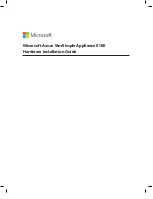
18
CrossFire 8730 Switch Reference Guide, DOC-7047 v. 1.1
Switch Overview
The switch bridging modes are founded on the concept of Logical Rings (LR) or
Logical Segments in Ethernet. The Logical Ring is represented on the switch by the
DTR (IEEE 802.5r) standard’s Concentrator Relay Function (CRF). A Logical
Ring may consist of interconnected CRFs on different switches.
Each port on the switch belongs to a CRF, which is a logical grouping of ports
within the switch. A CRF can consist of any number of ports within a switch or a
switch stack. The ports within a CRF do not have to be adjacent.
The Logical Rings and, subsequently, the CRFs, are assigned an unique ring
number each when the switch performs source routing functions. The bridging is
performed through the logical entity of the Bridge Relay Function (BRF).
The CRF communicates via a logical, virtual port with the Bridge Relay Function,
which functions as a multiport (virtual) bridge between the Logical Rings. The
switch can support up to 63 logical rings.
There are two levels of relay functions supported by the switch. The first level is
the TrCRF (Token-Ring Concentrator Relay Function) to which the ports are
assigned. The second level is the TrBRF (Token-Ring Bridge Relay Function). This
is the parent relay function to which TrCRFs are assigned. The switch maintains
certain configuration information and management statistics on a per BRF/CRF
basis. Therefore, when you access VLAN-specific switch configuration or
management screens (such as the Current Spanning Tree Information screen),
you will be prompted to specify the desired TrBRF for TrCRF.
For specific information for the Fast Ethernet ports, see “Fast Ethernet Bridging
Modes” on page 23.
Source Route Switching (SRS)
This mode is used between ports comprising a Logical Ring.
SRS switching combines the normal transparent bridge function with the ability to
forward frames based on source route information to locally attached source-route
bridges. The switch does not otherwise act as a source route bridge. For non source-
routed packets, the switch decision is based upon destination MAC Addresses. For
source-routed packets, it is based on the source-route information combined with
the destination MAC address.
The switch learns MAC addresses and source-routing route descriptors of Source
Route Bridges attached to local switch ports.
Parallel paths are eliminated via the IEEE 802.1D Spanning Tree Protocol.
Source Route Bridging (SRB)
The BRF acts as a multiport Source Route Bridge between CRFs with the following
characteristics:
Summary of Contents for CrossFire 8730
Page 1: ...R e f e r e n c e G u i d e DOC 7047 1 1 CrossFireTM 8730 Fast Ethernet Translation Switch...
Page 2: ......
Page 3: ...CrossFire TM 8730 Fast Ethernet Translation Switch Reference Guide...
Page 6: ...iv CrossFire 8730 Switch Reference Guide DOC 7047 v 1 1...
Page 14: ...xii CrossFire 8730 Switch Reference Guide DOC 7047 v 1 1...
Page 28: ...14 CrossFire 8730 Switch Reference Guide DOC 7047 v 1 1 Introduction...
Page 146: ...132 CrossFire 8730 Switch Reference Guide DOC 7047 v 1 1 Switch Configuration...
Page 208: ...194 CrossFire 8730 Switch Reference Guide DOC 7047 v 1 1 Monitoring the Network with SNMP...
Page 220: ...206 CrossFire 8730 Switch Reference Guide DOC 7047 v 1 1 Abbreviations...
Page 232: ...index 12 CrossFire 8730 Switch Reference Guide DOC 7047 v 1 1 Index...
Page 233: ......
















































